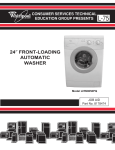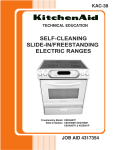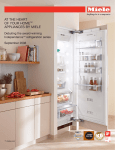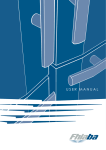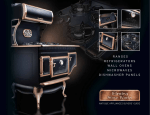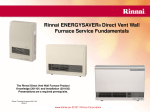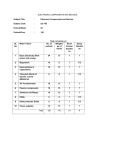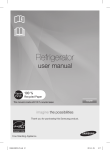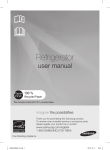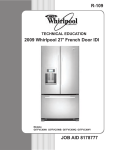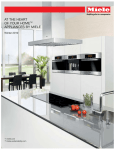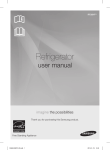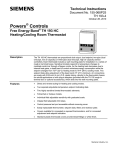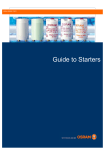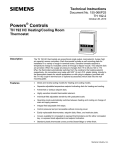Download Built-In French Door Bottom-Mount Refrigerator
Transcript
KAR-17 TECHNICAL EDUCATION BUILT-IN FRENCH DOOR BOTTOM-MOUNT REFRIGERATOR MODELS: KBFC42FS & KBFO42FS JOB AID 4317402 FORWARD This KitchenAid Job Aid, “Built-In French Door Bottom-Mount Refrigerator” (Part No.4317402), provides the In-Home Service Professional with information on the installation, operation, and service of the Built-In French Door Bottom-Mount Refrigerator. For specific information on the model being serviced, refer to the “Use and Care Guide,” or “Tech Sheet” provided with the refrigerator. The Wiring Diagrams used in this Job Aid are typical and should be used for training purposes only. Always use the Wiring Diagram supplied with the product when servicing the refrigerator. GOALS AND OBJECTIVES The goal of this Job Aid is to provide information that will enable the In-Home Service Professional to properly diagnose malfunctions and repair the Built-In French Door Bottom-Mount Refrigerator. The objectives of this Job Aid are to: • Understand and follow proper safety precautions. • Successfully troubleshoot and diagnose malfunctions. • Successfully perform necessary repairs. • Successfully return the refrigerator to its proper operational status. WHIRLPOOL CORPORATION assumes no responsibility for any repairs made on our products by anyone other than authorized In-Home Service Professionals. Copyright © 2006, Whirlpool Corporation, Benton Harbor, MI 49022 - ii - TABLE OF CONTENTS Page GENERAL . . . . . . . . . . . . . . . . . . . . . . . . . . . . . . . . . . . . . . . . . . . . . . . . . . . . . . . . . . . . . . Refrigerator Safety . . . . . . . . . . . . . . . . . . . . . . . . . . . . . . . . . . . . . . . . . . . . . . . . . . . . . . Model & Serial Number Designations . . . . . . . . . . . . . . . . . . . . . . . . . . . . . . . . . . . . . . . Model & Serial Number Label And Tech Sheet Locations . . . . . . . . . . . . . . . . . . . . . . . . 1-1 1-1 1-2 1-3 INSTALLATION INFORMATION . . . . . . . . . . . . . . . . . . . . . . . . . . . . . . . . . . . . . . . . . . . . . 2-1 Water Supply Requirements . . . . . . . . . . . . . . . . . . . . . . . . . . . . . . . . . . . . . . . . . . . . . . 2-1 PRODUCT OPERATION . . . . . . . . . . . . . . . . . . . . . . . . . . . . . . . . . . . . . . . . . . . . . . . . . . . 3-1 Theory Of Operation . . . . . . . . . . . . . . . . . . . . . . . . . . . . . . . . . . . . . . . . . . . . . . . . . . . . 3-1 Refrigerator Use . . . . . . . . . . . . . . . . . . . . . . . . . . . . . . . . . . . . . . . . . . . . . . . . . . . . . . . . 3-9 COMPONENT ACCESS . . . . . . . . . . . . . . . . . . . . . . . . . . . . . . . . . . . . . . . . . . . . . . . . . . . 4-1 Component Locations . . . . . . . . . . . . . . . . . . . . . . . . . . . . . . . . . . . . . . . . . . . . . . . . . . . 4-1 Removing A Refrigerator Light Socket . . . . . . . . . . . . . . . . . . . . . . . . . . . . . . . . . . . . . . . 4-3 Removing The User Interface Assembly . . . . . . . . . . . . . . . . . . . . . . . . . . . . . . . . . . . . . 4-4 Removing The Refrigerator Thermistor . . . . . . . . . . . . . . . . . . . . . . . . . . . . . . . . . . . . . . 4-5 Removing The Refrigerator Motorized Air Door . . . . . . . . . . . . . . . . . . . . . . . . . . . . . . . . 4-6 Removing A Refrigerator Temp-Controlled Motorized Air Door . . . . . . . . . . . . . . . . . . . . 4-7 Removing A Temp-Controlled Drawer Cover . . . . . . . . . . . . . . . . . . . . . . . . . . . . . . . . . . 4-8 Removing The Heated Flipper Mullion And An Actuator/Electrical Contact . . . . . . . . . . 4-10 Removing The Unit Compartment Components . . . . . . . . . . . . . . . . . . . . . . . . . . . . . . 4-12 Removing A Refrigerator Door Switch . . . . . . . . . . . . . . . . . . . . . . . . . . . . . . . . . . . . . . 4-17 Removing A Refrigerator Door Skin And Handle . . . . . . . . . . . . . . . . . . . . . . . . . . . . . . 4-18 Removing A Refrigerator Door . . . . . . . . . . . . . . . . . . . . . . . . . . . . . . . . . . . . . . . . . . . . 4-19 Removing The Freezer Drawer Slides . . . . . . . . . . . . . . . . . . . . . . . . . . . . . . . . . . . . . . 4-20 Removing The Freezer Drawer Switch . . . . . . . . . . . . . . . . . . . . . . . . . . . . . . . . . . . . . 4-21 Removing The Ice Maker & Fill Tube Heater . . . . . . . . . . . . . . . . . . . . . . . . . . . . . . . . . 4-22 Removing The Ice Maker Optics . . . . . . . . . . . . . . . . . . . . . . . . . . . . . . . . . . . . . . . . . . 4-24 Removing The Evaporator Fan Motor . . . . . . . . . . . . . . . . . . . . . . . . . . . . . . . . . . . . . . 4-26 Removing The Bimetal, Defrost Heater, And Evaporator . . . . . . . . . . . . . . . . . . . . . . . . 4-27 Removing The Water Valve . . . . . . . . . . . . . . . . . . . . . . . . . . . . . . . . . . . . . . . . . . . . . . 4-30 Removing The Water Filter Housing . . . . . . . . . . . . . . . . . . . . . . . . . . . . . . . . . . . . . . . 4-31 - iii - COMPONENT TESTING . . . . . . . . . . . . . . . . . . . . . . . . . . . . . . . . . . . . . . . . . . . . . . . . . . . Thermistor . . . . . . . . . . . . . . . . . . . . . . . . . . . . . . . . . . . . . . . . . . . . . . . . . . . . . . . . . . . . Heated Flipper Mullion . . . . . . . . . . . . . . . . . . . . . . . . . . . . . . . . . . . . . . . . . . . . . . . . . . . Motorized Air Door . . . . . . . . . . . . . . . . . . . . . . . . . . . . . . . . . . . . . . . . . . . . . . . . . . . . . . Power Switch . . . . . . . . . . . . . . . . . . . . . . . . . . . . . . . . . . . . . . . . . . . . . . . . . . . . . . . . . . 24V Transformer . . . . . . . . . . . . . . . . . . . . . . . . . . . . . . . . . . . . . . . . . . . . . . . . . . . . . . . Condenser Fan Motor . . . . . . . . . . . . . . . . . . . . . . . . . . . . . . . . . . . . . . . . . . . . . . . . . . . Evaporator Fan Motor . . . . . . . . . . . . . . . . . . . . . . . . . . . . . . . . . . . . . . . . . . . . . . . . . . . Compressor & Inverter . . . . . . . . . . . . . . . . . . . . . . . . . . . . . . . . . . . . . . . . . . . . . . . . . . . Door/Drawer Switch . . . . . . . . . . . . . . . . . . . . . . . . . . . . . . . . . . . . . . . . . . . . . . . . . . . . . Fill Tube Heater . . . . . . . . . . . . . . . . . . . . . . . . . . . . . . . . . . . . . . . . . . . . . . . . . . . . . . . . Defrost Heater & Bimetal . . . . . . . . . . . . . . . . . . . . . . . . . . . . . . . . . . . . . . . . . . . . . . . . . Water Valve . . . . . . . . . . . . . . . . . . . . . . . . . . . . . . . . . . . . . . . . . . . . . . . . . . . . . . . . . . . Main Control Board . . . . . . . . . . . . . . . . . . . . . . . . . . . . . . . . . . . . . . . . . . . . . . . . . . . . . 5-1 5-1 5-2 5-2 5-3 5-3 5-4 5-4 5-5 5-6 5-6 5-7 5-7 5-8 DIAGNOSTICS & TROUBLESHOOTING . . . . . . . . . . . . . . . . . . . . . . . . . . . . . . . . . . . . . . 6-1 WIRING DIAGRAMS . . . . . . . . . . . . . . . . . . . . . . . . . . . . . . . . . . . . . . . . . . . . . . . . . . . . . . 7-1 TECH TIPS . . . . . . . . . . . . . . . . . . . . . . . . . . . . . . . . . . . . . . . . . . . . . . . . . . . . . . . . . . . . . . 8-1 Adjusting A Refrigerator Door . . . . . . . . . . . . . . . . . . . . . . . . . . . . . . . . . . . . . . . . . . . . . 8-1 Adjusting The Freezer Door . . . . . . . . . . . . . . . . . . . . . . . . . . . . . . . . . . . . . . . . . . . . . . . 8-2 - iv - GENERAL REFRIGERATOR SAFETY Your safety and the safety of others are very important. We have provided many important safety messages in this manual and on your appliance. Always read and obey all safety messages. This is the safety alert symbol. This symbol alerts you to potential hazards that can kill or hurt you and others. All safety messages will follow the safety alert symbol and either the word “DANGER” or “WARNING.” These words mean: DANGER You can be killed or seriously injured if you don’t immediately follow instructions. WARNING You can be killed or seriously injured if you don’t follow instructions. All safety messages will tell you what the potential hazard is, tell you how to reduce the chance of injury, and tell you what can happen if the instructions are not followed. 1-1 MODEL & SERIAL NUMBER DESIGNATIONS MODEL NUMBER MODEL NUMBER K BF C 42 F S 21 10001 PRODUCT GROUP K = KitchenAid PRODUCT IDENTIFICATION BF = BTM Freezer, French Door MERCHANDISING SCHEME / SERIES C = Wrap Around Stainless Steel O = Overlay Model WIDTH 42 = 42˝ MODEL FEATURES F = Factory Installed Ice Maker & Filter YEAR OF INTRODUCTION S = 2006 COLOR CODE X = No Color S = Stainless ENGINEERING CHANGE DIGITS SERIAL NUMBER SERIAL NUMBER Q T MANUFACTURING LOCATION Q = LaVergne, TN YEAR OF PRODUCTION T = 2006 WEEK OF PRODUCTION 21st Week PRODUCT SEQUENCE NUMBER 1-2 S 00 MODEL & SERIAL NUMBER LABEL AND TECH SHEET LOCATIONS The Model/Serial Number label and Tech Sheet locations are shown below. Model & Serial Number Label Location (On Upper Left Side Of Refrigerator Liner) Tech Sheet Location 1-3 — NOTES — 1-4 INSTALLATION INFORMATION WATER SUPPLY REQUIREMENTS If the water pressure to the reverse osmosis system is less than 40 to 60 psi (276-414 kPa): Water Pressure A cold water supply with water pressure between 30 and 120 psi (207-827 kPa) is required to operate the water dispenser and ice maker. • Check to see whether the sediment filter in the reverse osmosis system is blocked. Replace the filter if necessary. • Allow the storage tank on the reverse osmosis system to refill after heavy usage. • If the refrigerator has a water filter, it may further reduce the water pressure when used in conjunction with a reverse osmosis system. Remove the water filter. Reverse Osmosis Water Supply IMPORTANT: The pressure of the water supply coming out of a reverse osmosis system going to the water inlet valve of the refrigerator needs to be between 30 and 120 psi (207-827 kPa). If a reverse osmosis water filtration system is connected to your cold water supply, the water pressure to the reverse osmosis system needs to be a minimum of 40 psi. 2-1 — NOTES — 2-2 PRODUCT OPERATION THEORY OF OPERATION Reset Max Cool Holiday Mode Energy Saver Door Open ON/OFF Over Temperature Call Service Cooling Alarms THE ELECTRONIC CONTROL PANEL OVERVIEW The main electronic control board monitors the water valve for total elapsed time and gallons of water used. The number displayed on the Water Filter Indicator (WFI) is the percentage of filter usage remaining. The numeric display can be set for Fahrenheit or Celsius and displays the actual temperatures. The display range for the refrigerator is from 27°F to 70°F (–2.8°C to 21°C). The normal freezer display range is from –10°F to 70°F (–23°C to 21°C). Temperatures above or below these limits will be displayed at the corresponding temperature limit. During Max Cool, the freezer display will read –5°F (–21°C), and the refrigerator will read 34°F (1°C). The display will show the temperature setting any time the actual temperature is within ±6°F of the customer setting. This will prevent concern over temperature fluctuations when the doors are opened. The customer setting will also be displayed during the defrost period, and 30 minutes after defrost. Press the temperature adjustment key to view the current temperature setting, or to change the setting. When the temperature adjustment key is used to change the temperature setting, the display will brighten for 5 seconds. Available features include: • Water Filter Indicator • Max Cool • Over-Temperature Alarm • Holiday Mode • Energy Saver Mode The KitchenAid Built-In French Door BottomMount Refrigerator Constant Flow Temperature Management System uses two thermistors to monitor temperature changes inside the refrigerator and freezer compartments. Two electronic control boards are used in the refrigerator: a main electronic control board, and a low voltage (Phoenix) board. The main electronic control board manages the operation of the variable capacity compressor (VCC), a variable speed evaporator fan motor, and a variable position air door. The air door allows independent temperature control of the refrigerator and freezer compartments. The main electronic control board seeks the most efficient means possible to maintain temperatures as it controls the operation and speed of the compressor and the evaporator fan motor. Higher fan speed is used before increasing the compressor speed to minimize power consumption. A nearly constant run time is sought at the lowest possible fan and compressor speed. Freezer temperatures can be set from 5°F to –5°F (–15°C to –21°C). Refrigerator temperatures can be set from 45°F to 33°F, (7°C to 1°C). The Adaptive Defrost Control (ADC) portion of the main electronic control board utilizes “pulsed defrost” technology to perform the defrost function (see page 3-4). 3-1 TEMPERATURE CONTROL Freezer Temperature Control — Temperature Decreasing When the freezer temperature begins to decrease, the process will reverse. The compressor speed decreases, followed by the evaporator fan speed. The main electronic control board checks the resistance of the thermistors, and compares it to both the customer temperature settings and the last thermistor reading taken. This information is used to determine when to begin a cooling operation, and if a change is necessary in the damper setting, or the evaporator fan or compressor speed. When a warm refrigerator is first put into a cooling mode, the air door partially opens, and the compressor and evaporator fan motors start to run at maximum rpm. The air door will gradually move to its fully open position. As the actual temperature in the refrigerator nears the selected temperature setting, the electronic control compares the temperatures in both compartments. The compartment that has the greatest need for cooling will control the speed of the evaporator fan motor. Refrigerator Temperature Control — Temperature Increasing When the refrigerator calls for cooling while the freezer is satisfied, the air door begins to open, and the evaporator fan starts to run at minimum speed. If the temperature continues to rise, the air door will continue to open. If the temperature continues to rise after the air door is fully open, the evaporator fan speed will gradually increase to a maximum of 3000 rpm. If the temperature continues to rise, the compressor starts to run, or if it has already been running, begins to increase in speed. Refrigerator Temperature Control — Temperature Decreasing As the refrigerator temperature approaches the selected setting, the control compares the temperatures in both compartments to determine which compartment will control the fan speed. If the freezer is further from the selected temperature setting, it controls the fan speed, and the air door begins to close, thus reducing the airflow to the refrigerator. If the freezer is satisfied, the air door remains open, and the fan speed begins to decrease. When the selected temperature setting is reached, the air door closes. Freezer Temperature Control — Temperature Increasing When the freezer calls for cooling, the compressor begins to run at minimum rpm, (see the chart on page 3-3), and the evaporator fan begins to run at 2000 rpm. The compressor and evaporator speeds are continuously updated. Speed changes are made based on: • The difference between the actual temperature and the selected temperature settings. • The rate of temperature change. If the temperature increases 4°F above the selected temperature setting, the evaporator fan speed begins to gradually increase. The evaporator fan motor reaches the maximum speed of 3000 rpm at 5°F above the selected temperature setting, and the compressor speed begins to gradually increase. A maximum compressor speed of 4500 rpm will be reached at 9°F above the selected temperature setting. 3-2 COMPRESSOR COMPRESSOR PROTECTION The main control board supplies a 5 vdc, peakto-peak square wave, at 54 to 150 Hz, to the inverter board. A standard VOM will read approximately 2.5 vdc. The inverter board supplies the variable capacity compressor with three-phase 230 vac. Varying the voltage and frequency to the inverter board changes the speed of the compressor. The compressor can run at speeds of 1620 to 4500 rpm. NOTE: It is not necessary, nor is it recommended, to test the output of the inverter board. While the compressor is running, its speed is continuously updated. Speed is determined after analyzing two factors: • The difference between the actual temperature and the selected temperature settings. • The rate of temperature change. Minimum compressor speed is based on the freezer’s selected temperature setting, as shown in the following chart. To protect the compressor and maintain efficiency, minimum compressor off time is programmed into the main control board. When the compressor turns off, a minimum of 7 minutes must elapse before allowing a restart. At the end of the 7-minute period, the condenser fan motor starts, and the main control board sends the compressor speed signal to the inverter. The compressor will not start for an additional minute, due to the inverter delay. The inverter utilizes a current-limiting device and thermal protection that eliminates the need for a compressor-mounted thermal protector. The inverter will not allow a compressor restart for 8 minutes after the compressor turns off. This inverter delay will not occur after a power interruption, because inverter memory is lost (see “Power Interruption” on page 3-4). Freezer Temperature Setting (°F) Compressor Minimum Speed 6 to –2 1620 rpm –3 1800 rpm –4 2000 rpm –5 2200 rpm EVAPORATOR FAN MOTOR The evaporator fan motor is a 12 vdc, variable speed motor. The motor has four wires: • A blue wire that is not used. • A red wire provides a constant 12 vdc. • A yellow wire provides a variable voltage of between 5 vdc and 17 vdc to control the motor speed from 2000 to 3000 rpm. • A white wire provides a common return. The compressor generally cycles on and off according to the cut-in and cut-out temperatures of the freezer, however, the refrigerator can turn on the compressor if the evaporator fan is at maximum speed and the refrigerator temperatures are not dropping. EVAPORATOR FAN & AIR DOOR DELAY After defrost, an evaporator fan delay prevents unnecessary movement of warm, moist air through the refrigerator by chilling the evaporator prior to starting the fan. Immediately after defrost drip time, the compressor starts at 4500 rpm, but the evaporator fan is delayed for 8 minutes. Also, the air door remains closed during the 8-minute delay. 3-3 AIR DOOR When entering a defrost cycle, if the bimetal is open, the time to defrost is reset to 8 hours, and the control will time through the entire 37-minute defrost period. During diagnostics this will allow a technician time to look for heater operation, and if necessary, bypass the bimetal. The air door is driven by a reversible DC stepper motor. The motor operates on a 12 vdc, peakto-peak square wave. Voltage is delivered to the air door in a series of short pulses. It is not possible to obtain a reliable voltage reading with a VOM. Separate windings are used to move the air door open or closed. The door can be in any position from 0 to 90 degrees. The air door is used to fine-tune the airflow to the refrigerator. The refrigerator temperature determines the opening of the air door. When the refrigerator requires cooling, if the evaporator fan motor is already running for the freezer, the air door partially opens, and then adjusts, if necessary. While the refrigerator is cooling, the door will be adjusting continuously to maintain or recover refrigerator temperature. POWER INTERRUPTION After a power interruption, the following events will occur: • The refrigerator returns to the same operating mode and settings in use prior to the power interruption. If the unit was off, it remains off. • Initially, the compressor, evaporator fan, and condenser fan motors will be off. • The air door will close, and then adjust to the proper opening. The evaporator fan starts when the air door opens. • The adaptive defrost control resets the compressor run time counter to 0, and if the freezer is above 20°F, the time to defrost is set to 8 hours. • If the freezer temperature is below 12°F (–11.1°C), the compressor starts after a delay of 7 minutes. If the freezer temperature is above 12°F, the compressor starts immediately. ADAPTIVE DEFROST The adaptive defrost control function of the main electronic control board allows the refrigerator to enter a defrost mode only when it is needed. When powered up for the first time, the control initiates a defrost cycle after 8 hours of compressor run time. By monitoring the duration of defrost heating time and compressor run time, the control will continuously adapt the time between defrosts to optimize efficiency. Time between defrost periods will vary between 8 and 100+ hours. Defrost will occur immediately when the compressor has run at 4000 rpm or greater for 1 hour, and 8 hours have elapsed since the last defrost. FAILURE DEFAULTS In the event of a thermistor, or keypad failure, the main electronic control board uses one of the following default modes, which will continue until the failure is corrected. Refrigerator Thermistor If the main electronic control board senses an open or a shorted thermistor, the air door and the evaporator fan motor will begin to operate on a timed on and off cycle, based on current selected temperature settings. The evaporator fan motor will run when the air door is open. At mid-settings of 37°F / 3°C, the air door will open for 16 minutes, and close for 30 minutes. Setting the freezer colder, or the refrigerator warmer, will reduce the door-open time. Setting the freezer warmer, or the refrigerator colder, will increase the door-open time. PULSED DEFROST For the first 2 minutes of defrost, the heater is on continuously. It will then cycle off for 1 minute, and back on for 2 minutes. The heater will continue to cycle at this ratio until the bimetal opens, or until 33 minutes has elapsed. At this point, heat is discontinued, and a 4-minute “drip time” begins. This allows the water to drain before the refrigerator returns to a cooling mode. Maximum defrost time, (pulsed heat on/off time + drip time) is 37 minutes. 3-4 MAX COOL MODE Freezer Thermistor If the main electronic control board senses an open or a shorted thermistor, the compressor and the evaporator fan motor will begin to operate on a timed on and off cycle. The cycle time is based on current selected temperature settings. At mid-settings of 37°F / 3°C, the compressor and the evaporator fan motors will run for 35 minutes, and be off for 25 minutes. Setting the freezer colder will increase the run time. Setting the freezer warmer will decrease the run time. The compressor will run at minimum speed. The evaporator fan will also run at minimum speed, unless the refrigerator compartment requests a higher speed. Keypad If the main electronic control board detects that the keypad is not working, it reverts to the default temperature settings of 37°F (3°C) in the refrigerator, and 0°F (–18°C) in the freezer. Max Cool changes the refrigerator temperature setting to 34°F (1°C) and the freezer to –5°F (–21°C) for 24 hours. During Max Cool, the freezer and refrigerator temperature displays show the new temperature settings, not the actual temperatures. In most cases the motors run 100% for more than 1 hour. The control returns to the previous user setting after 24 hours, or any time the temperature settings are changed. AUTOMATIC MAX ICE Automatic Max Ice operates any time the ice maker water valve is energized. The duration of Automatic Max Ice is 1-1/2 hours. During Automatic Max Ice the following occurs: • The freezer display shows the user temperature settings and not the actual temperature. • The freezer temperature setting changes to –5°F (–21°C). • The evaporator fan runs at 3000 rpm. • The compressor runs the entire 1-1/2 hour mode. Speed is determined by the difference between actual freezer temperature and –5°F (–21°C). Evaporator Fan Motor If the evaporator fan motor malfunctions, the compressor will run at 4500 rpm for an indefinite period, except during the defrost periods. HOLIDAY MODE The Holiday Mode may be used for the following occasions: • On vacation. • Religious observance (Sabbath Mode). • When the Holiday Mode is selected, the corresponding backlit blue LED flashes for 5 seconds, and then remains on, to indicate that the feature is activated. 3-5 MASTER ALARM RESET In the Holiday Mode the following occurs: • Temperature selections remain at the current setting, but are not displayed. • The Water Filter Indicator is not displayed, but monitoring continues. • The alarms are disabled. • The ice maker is disabled. • The interior lights are disabled. • The temperature displays and all of the LEDs will be off, except for the Holiday Mode and Cooling On/Off LEDs. The Holiday Mode and Cooling On/Off LEDs will illuminate regardless of the door position. • Keypad operation is disabled, with the exception of the Holiday Mode key, or the Power On/Off key. Pressing the Over Temperature Reset will turn off the audio alarm, but does not affect the indicator light the first time the Over Temperature Reset is pressed. The indicator light will turn off once the Over Temperature Reset is pressed a second time. The audio alarm will not sound again for the current condition that caused the alarm until a new condition occurs. A Master Alarm Reset can be performed by turning the power to the refrigerator off and on again. The indicator light will turn on again after the Over Temperature Reset is pressed, if the condition that caused the alarm is still present. CALL SERVICE ALARM The Holiday Mode will be cancelled when the following occurs: • Pressing the Power On/Off, or Holiday Mode keypads. When the Holiday Mode is cancelled, the Holiday Mode LED turns off, and the control reverts to the settings in use prior to activation. All inactive devices are restored, and the Water Filter Indicator is updated. The Adaptive Defrost Control function continues during the Holiday Mode, but the control will defrost at a fixed 12-hour interval. Call Service is a visual and audio signal that alerts the user that the refrigerator needs service. The Call Service Alarm will sound when: • Either thermistor has failed. • An over-temperature condition occurs for 3 hours or more. • Reset using Master Alarm Reset. • Communication is lost with either the low voltage Phoenix or main electronic control board. OVER TEMPERATURE ALARM If any door is left open for more than 10 minutes, the interior lights will be disabled, the Door Open icon will flash, and the alarm will sound. If the door is closed during the alarm operation, the alarm will reset. DOOR OPEN ALARM The Over Temperature Alarm sounds, and the indicator light flashes when either the refrigerator temperature exceeds 48°F (9°C), or the freezer temperature exceeds 15°F (–9°C) for over 1-1/2 hours. The appropriate temperature display flashes to show the user which compartment is effected. The alarm stops if the temperature(s) returns to normal, but the red Over Temperature LED will continue to flash (refer to “Master Alarm Reset” to reset the Over Temperature Alarm). SALES DEMONSTRATION MODE This mode provides a sequential display of the temperature displays and feature LEDs. To enter the Demonstration Mode, press and hold the Max Cool and Power On/Off keys for 2 seconds. If the refrigerator or freezer door is open for 10 minutes, the interior lights will turn off. 3-6 LOW VOLTAGE PHOENIX CONTROL BOARD Ingredient Care Center Temperature Control The control monitors the temperature of each ingredient care center pan by means of a thermistor located in the top of each pan. When cooling is needed the Phoenix control sends a request to the main control board to operate the evaporator fan motor. The Phoenix control board does not have direct control of the evaporator fan motor. The Phoenix control also sends a 12 vdc, peak to peak square wave to the ingredient care center air door to open the door. The ingredient care center air door will be in one of five possible positions based on the ingredient care center user setting. The air door will close at any setting when the proper temperature has been reached. Here are the four possible positions and temperatures for each setting. • Closed. - When the refrigerator compartment is calling for cooling and the freezer is satisfied. This allows the refrigerator to cool faster. - Any setting when proper pan temperature has been achieved. - When the refrigerator is in holiday mode. - When the refrigerator is in defrost mode. • Deli—40°F, open at a 10° angle. • Produce—39°F, open at a 20° angle. • Meats—33°F, open at a 30° angle. • Quick Chill—25°F, open at a 45° angle. A low voltage transformer, located on the left side of the unit compartment, supplies 24 volts ac to the Phoenix control board. The Phoenix control provides the following functions: • Communicates with both ingredient care center pans. • Provides 24 volts dc to both ingredient care center pans to operate the LED lighting in each ingredient care center pan. • Monitors a thermistor in each ingredient care center pan. • Controls the operation of the motorized air baffle for each ingredient care center pan. • Provides 24 volts dc to the heated flipper mullion to prevent condensation on the flipper mullion. • Communicates with the main electronic control. This includes the status of the refrigerator door switches and evaporator fan motor. The two controls communicate and work together to provide proper function. The Phoenix control operates the ingredient care center pan LED lighting and the mullion heater but it does not get direct input on the position of the refrigerator door switches. In order to operate the LED pan lighting at the proper time, the main control monitors the refrigerator door switches and sends a communication on the data line to let the Phoenix control know when a refrigerator door is opened. The Phoenix control supplies 24 volts dc to the mullion heater when both refrigerator doors are closed. When a refrigerator door is opened, or an ingredient care center pan air door change is needed, the output of the Phoenix control board is switched from the mullion heater to the ingredient care center pan. When Quick Chill is selected, the pan temperature is set to 25°F, and the freezer temperature is set to –5°F, for one hour. The evaporator fan motor operates and runs at high speed until the set temperature is reached. When the hour has timed out, the ingredient care center user interface and the freezer temperature both return to the previous customer settings. 3-7 AIR CIRCULATION It is important not to block any of the vents with food items. If the vents are blocked, airflow will be restricted, and the temperature management system will not function properly. IMPORTANT: Because air circulates between both sections, any odors formed in one section will transfer to the other. Keep both sections clean, and wrap or cover foods tightly to help avoid the transfer of odors from food to ice. In order to ensure proper temperatures, you need to permit airflow between the refrigerator and freezer sections. As shown in the illustration, cool air enters the freezer section through vents in the rear and top. The air flows forward through the freezer section and recirculates under the freezer floor. Cool air enters the refrigerator section through the top, flows down and across shelves to the doors and recirculates to return air vents at the bottom. 3-8 REFRIGERATOR USE ENERGY SAVER™ FEATURE (42˝ BOTTOM MOUNT ONLY) MAX COOL The Max Cool feature assists with periods of heavy ice usage, full grocery loads, or temporarily warm room temperatures. • Press MAX COOL to turn on the Max Cool feature. The Max Cool indicator light will remain on for 24 hours unless manually turned off. The Energy Saver feature controls the heaters located inside the hinged seal between the refrigerator doors. The heaters help keep external moisture from forming on the hinged seal. • Press ENERGY SAVER control to turn on this feature for low humidity conditions. The ring around the control will be lit when Energy Saver is on. If moisture begins to collect on the hinged seal between the doors, press ENERGY SAVER control again to turn off this feature. NOTE: The temperature display will remain at 34°F (1°C) and –5°F (–21°C) for the refrigerator and freezer compartments, respectively, while the Max Cool feature is enabled. After 24 hours, the refrigerator returns to the previous temperature set points. ALARM FUNCTIONS HOLIDAY MODE Master Alarm Reset Pressing Alarm Reset once will turn off the audio alarm and indicator light. The audio alarm will not sound again for the current condition that caused the alarm until a new condition occurs or until a Master Alarm Reset is performed. A Master Alarm Reset can be performed by pressing Cooling (ON/OFF) twice or by turning the power to the refrigerator off and on again. After performing a Master Alarm Reset, the indicator light will reactivate if the condition that caused the alarm is still present. The Holiday Mode feature is designed for the traveler or for those whose religious observances require turning off the lights and ice maker. By selecting this feature, the temperature set points and Deli Pan settings remain unchanged, the ice maker will be disabled and the interior lights will turn off. For most efficient refrigerator operation, it is recommended to exit the Holiday Mode when it is no longer required. • Press HOLIDAY MODE to turn on the Holiday Mode feature. This feature will remain on until Holiday Mode is pressed again. NOTE: If the Max Cool feature has been selected prior to turning on the Holiday Mode feature, then the set points will remain at 34°F (1°C) and -5°F (-21°C) for the refrigerator and freezer compartments, respectively, until the Max Cool feature times out. The refrigerator will then return to the previous temperature set points chosen prior to the selection of the Max Cool feature, but the lights and ice maker will remain off until the Holiday Mode is pressed again. Door Open The Door Open indicator light will flash, an alarm will sound and the interior lights will turn off when a door has been open for longer than 10 minutes. When the door is closed, the audio alarm will reset and turn off, but the Door Open indicator light will continue to flash until the temperature is equal to or below 45°F (7°C) and 15°F (-9°C) for the refrigerator and freezer compartments, respectively. NOTE: To deactivate the audio alarm and indicator light, see “Master Alarm Reset.” 3-9 Over Temperature IMPORTANT: If the Over Temperature Alarm activates, your food may spoil (see “Power Interruptions” in the Use and Care Guide for additional information). Minimize door openings until temperatures return to normal. The Over Temperature feature is designed to let you know when either the refrigerator temperature rises above 48°F (9°C) or the freezer temperature rises above 15°F (–9°C) for longer than 1-1/2 hours. The audio alarm will shut off automatically when the temperature returns to normal, but the indicator light will continue to flash until the Alarm is pressed to let you know that an over temperature condition has occurred. If the over temperature condition is still present when an Over Temperature Reset is performed, the indicator light will continue to reactivate every 1-1/2 hours until refrigerator and freezer temperatures are below 48°F (9°C) and 15°F (–9°C), respectively. NOTE: To deactivate the audio alarm and indicator light, see “Master Alarm Reset.” 2. To manually turn off the ice maker, slide the ice maker ON/OFF control to the OFF (down) position as shown. A A. ON/OFF control DELI/CRISPER PANS The 42˝ (106.7 cm) model includes two deli pans and two crisper pans, while the 36˝ (91.4 cm) model has one deli pan and one crisper pan. A B ICE MAKER Turn the Ice Maker ON/OFF The ice maker ON/OFF control is located on the left-hand side of the ice bin. 1. To turn on the ice maker, slide the ice maker ON/OFF control to the ON (up) position. NOTE: Your ice maker has an automatic shutoff. As ice is made, the ice cubes will fill the ice storage bin. The ice maker sensors will automatically stop ice production, but the ice maker control will remain in the ON (up) position. B A. Crisper pans B. Deli pans Deli Pan Settings The Ingredient Care Center control panel located above each deli pan has the following three temperature settings: Deli, Produce, Meats (Cold to Coldest) and the Quick Chill setting. Select the appropriate setting for the food being stored. 3-10 Meat Storage Guide Store most meat in original wrapping as long as it is airtight and moisture-proof. Rewrap if necessary. When storing meat longer than the times shown below, freeze the meat. Fresh fish or shellfish: Use same day as purchased. Chicken, ground beef, variety meat (liver, etc.): 1-2 days. Cold cuts, steaks & roasts: 3-5 days. Cured meats: 7-10 days. Leftovers: Cover leftovers with plastic wrap, aluminum foil, or plastic containers with tight lids. Quick Chill Setting Each deli pan has a Quick Chill setting. Activating this selection lowers the temperature of the pan for a period of one hour. NOTE: This will lower the deli pan temperature below the freezing point for liquids. 3-11 — NOTES — 3-12 COMPONENT ACCESS This section instructs you on how to service components inside the Built-In French Door BottomMount Refrigerator. The components and their locations are shown below. COMPONENT LOCATIONS WARNING Electrical Shock Hazard Disconnect power before servicing. Replace all parts and panels before operating. Failure to do so can result in death or electrical shock. Unit Compartment Components Inverter Compressor Condenser Fan Motor 24V Transformer Main Control Board Power Switch 4-1 Low Voltage Control Board Refrigerator Compartment Components Refrigerator User Interface & Door Switch Refrigerator Lighting (Behind Top Grille) Refrigerator Refrigerator Motorized Air Door Thermistor Refrigerator Door Switch (Behind Top Grille) Refrigerator Temp-Controlled Drawer Covers Heated Flipper Mullion Temp-Controlled Motorized Air Doors Freezer Compartment Components & Water Valve / Filter Housing Ice Maker Optics Emitter Board Ice Maker & Heater Evap. Fan Motor Ice Maker Optics Receiver Board Ice Maker On/Off Switch Evaporator, Drawer Switch Bimetal, & Drawer Slide Defrost Heater 4-2 Water Valve Filter Housing REMOVING A REFRIGERATOR LIGHT SOCKET 5. WARNING Using a small flat-blade screwdriver, push in on the light socket retainer, and pull the socket out of its opening in the refrigerator liner. Light Socket Retainer Electrical Shock Hazard Disconnect power before servicing. Replace all parts and panels before operating. Failure to do so can result in death or electrical shock. 1. 2. 3. Light Socket Unplug refrigerator or disconnect power. If needed, remove the food and racks from the upper shelf. Place the fingers of both hands into the light cover slots and pull the cover down. 6. Disconnect the two wires from the bulb holder terminals and remove the holder. Light Socket Wires Light Cover Slots 4. Unscrew the bulb from the light socket you are removing. Refrigerator Lights 4-3 REMOVING THE USER INTERFACE ASSEMBLY 4. WARNING Electrical Shock Hazard Disconnect power before servicing. Replace all parts and panels before operating. Failure to do so can result in death or electrical shock. 1. 2. 3. Remove the six hex-head screws from the user interface frame and remove the frame. User Interface Frame Screws (3 of 6) 5. Unplug refrigerator or disconnect power. If needed, remove the food and racks from the upper shelf. Place the fingers of both hands into the light cover slots and pull the cover down. Pull the user interface assembly forward and remove it from the five retainer clips. User Interface Clips 6. Unlock and disconnect the user interface connector from the wiring harness. Light Cover Slots User Interface Connector 4-4 REMOVING THE REFRIGERATOR THERMISTOR 3. WARNING Remove the hex-head screw from the refrigerator thermistor and pull the thermistor away from the liner. Refrigerator Thermistor Screw Electrical Shock Hazard Disconnect power before servicing. Replace all parts and panels before operating. Failure to do so can result in death or electrical shock. 1. 2. Unplug refrigerator or disconnect power. If needed, remove the food and racks from the upper shelf. 4. Unlock and disconnect the refrigerator thermistor connector from the wiring harness and remove the thermistor. Refrigerator Thermistor Connector Refrigerator Thermistor 4-5 REMOVING THE REFRIGERATOR MOTORIZED AIR DOOR 5. WARNING Unlock and disconnect the motorized air door connector from the wiring harness and remove the air door and cover. Motorized Air Door Connector Electrical Shock Hazard Disconnect power before servicing. Replace all parts and panels before operating. Failure to do so can result in death or electrical shock. 1. 2. 6. Unplug refrigerator or disconnect power. If needed, remove the food and racks from the upper shelf. Peel off the adhesive covering from over the motorized air door, and remove the air door from the cover. Adhesive Covering Refrigerator Motorized Air Door Motorized Air Door 3. 4. Remove the three hex-head screws from the motorized air door cover. Pull down on the motorized air door cover to unhook it from the rear clips and turn it over. Motorized Air Door Cover Screws 4-6 REMOVING A REFRIGERATOR TEMP-CONTROLLED MOTORIZED AIR DOOR 5. WARNING Disconnect the motorized air door wire connector from the wire harness, and remove the air door. Motorized Air Door Connector Electrical Shock Hazard Disconnect power before servicing. Replace all parts and panels before operating. Failure to do so can result in death or electrical shock. 1. 2. 6. Unplug refrigerator or disconnect power. Remove the temp-controlled drawer for the motorized air door you are removing. Peel off the adhesive covering from over the motorized air door, and remove the air door. Temp-Controlled Motorized Air Doors Adhesive Covering 3. 4. Remove the two hex-head screws from the motorized air door cover. Pull the motorized air door assembly forward and turn it over. Air Door Cover Screws 4-7 REMOVING A TEMP-CONTROLLED DRAWER COVER WARNING Electrical Shock Hazard Disconnect power before servicing. Replace all parts and panels before operating. Failure to do so can result in death or electrical shock. 1. 2. Center Divider Cover Screws (2 of 4) Unplug refrigerator or disconnect power. Remove the temp-controlled drawer for the cover you are removing. NOTE: The temp-controlled drawer cover includes the user Interface & LED lighting. 4. Rotate the front of the center divider cover up, pull out, and remove the cover. Temp-Controlled Drawer Covers Center Divider Cover 3. Remove the four (two on both sides) hexhead screws from the center divider cover (see the top right photo). 4-8 5. Disconnect the wire connector on the temp-controlled drawer cover from the wiring harness. 6. Remove the two screws from the tempcontrolled drawer cover and remove the cover. TC Drawer Cover Screws Left Cover Connector (8-Pin) Right Cover Connector (6-Pin) 4-9 REMOVING THE HEATED FLIPPER MULLION AND AN ACTUATOR / ELECTRICAL CONTACT b) While lifting the flipper mullion, insert a small flat-blade screwdriver behind each of the three mullion retainer clips, pry the pins out of the door liner holes, and remove the flipper mullion. WARNING Mullion Electrical Shock Hazard Disconnect power before servicing. Replace all parts and panels before operating. Failure to do so can result in death or electrical shock. 1. 2. Unplug refrigerator or disconnect power. Open the left refrigerator door. 3. To remove the heated flipper mullion: a) Rotate the flipper mullion out. Pin Mullion Mullion 4-10 4. To remove the top or bottom heated flipper mullion actuator/electrical contact: a) Open the refrigerator doors. d) Remove the two hex-head screws from the actuator/electrical contact. Actuator / Electrical Contact Screws Top Mullion Actuator/ Electrical Contact e) Disconnect the spade connector from the actuator/electrical contact terminal. Actuator / Electrical Contact Terminal Bottom Mullion Actuator/ Electrical Contact b) Use a flat-blade screwdriver, and unscrew the cap from the actuator/electrical housing. c) Pry off the cover from the actuator/ electrical contact. Screw Cap Actuator / Electrical Contact Cover Bottom Mullion Actuator / Electrical Housing 4-11 REMOVING THE UNIT COMPARTMENT COMPONENTS Condenser Inverter Compressor Fan Motor Main & LV Boards WARNING Electrical Shock Hazard Disconnect power before servicing. Replace all parts and panels before operating. Failure to do so can result in death or electrical shock. 1. 2. 24V Transformer 4. To remove the power switch: a) Push the bottom of the switch forward as far as possible, then use a flat-blade screwdriver, and alternately press the top retainers against the switch body. Push the switch out of the bracket cutout. Unplug refrigerator or disconnect power. Lift the decorative panel off the pins at each end and remove the panel. Top Retainers Decorative Panel 3. Power Switch Remove the eight hex-head screws from the front cover of the unit compartment and remove the cover. b) Disconnect the four wire connectors from the power switch terminals, and remove the switch. Unit Compartment Front Cover (8 Screws) Wire Connectors (4) Power Switch Pinouts (1) Unused (2) WH (3) Line (Ribbed) (4) Unused (5) BK (6) Line (Smooth) 4-12 Top Retainers 5. To remove the 24 volt transformer: a) Disconnect the two wire connectors from the wire harness. b) Remove the two hex-head screws and remove the transformer. b) Disconnect the six wire connectors from the control board. c) Press in on the locking tab and lift the control board off each of the five standoffs. 24V Transformer Screws Standoff Locking Tab P8 P4 P3 P6 Connectors Main Control Board 6. To remove the main control board: a) Remove the three hex-head screws from the power switch bracket and move the bracket out of the way. P5 P7 Continued on the next page. 3 Power Switch Bracket Screws 4-13 7. To remove the low voltage control board: a) Disconnect the three wire connectors from the control board. b) Press in on the locking tab and lift the control board off each of the four standoffs. Inverter 2 Connectors Standoff Locking Tab 2 Screws P5 c) Insert a screwdriver into the side opening of the compressor terminal cover, pry out on the cover, and unsnap it from the compressor. P4 P2 Side Opening Terminal Cover Low Voltage Board 8. To remove the inverter: a) Disconnect the two wire connectors from the wiring harness (see the top right photo). b) Remove the two hex-head screws from the front of the inverter, and position the inverter out of the way of the compressor terminal cover. 4-14 d) Disconnect the 3-pin connector from the compressor pins. e) Disconnect the ground wire from the compressor terminal. Condenser Fan Motor Ground Wire 3-Pin Connector Bracket Screws f) Remove the screw from the chassis ground wire and remove the inverter. b) Press down on the locking tabs and pull the wire connector off the fan motor. c) Remove the speed nut from the blade and remove the blade from the motor shaft. Speed Nut Connector Ground Wire & Screw d) Remove the two hex-head screws from the fan motor and remove the motor from the bracket. 9. To remove the condenser fan motor: a) Remove the hex-head screws from the fan motor bracket (see the top right photo). Motor Screws 4-15 Continued on the next page. 10. To remove the compressor: a) Remove the front and rear screws from the unit compartment cover and lift the cover off the unit compartment. Terminal Cover Ground Wire 3-Pin Connector Compressor Filter-Drier b) Insert a screwdriver into the side opening of the compressor terminal cover, pry out on the cover, and unsnap it from the compressor. e) IMPORTANT: Refrigerant must be handled by a licensed, EPA-certified refrigerant technician in accordance with established procedures. Remove the refrigerant from the existing system per the instructions provided with the recovery system being used. f) Unbraze the suction and discharge lines from the compressor. g) Cut the filter-drier from the system (do not use a torch). Suction Line Side Opening Terminal Cover Discharge Line Filter-Drier c) Disconnect the 3-pin connector from the compressor pins (see the top right photo). d) Disconnect the ground wire from the compressor terminal. 4-16 h) Remove the 5/16˝ mounting bolts from the rubber grommets of the compressor. i) Lift the old compressor off the refrigerator. j) Install the new components and reconnect the ground wire (see top photo). REMOVING A REFRIGERATOR DOOR SWITCH 4. WARNING Electrical Shock Hazard Disconnect power before servicing. Replace all parts and panels before operating. Failure to do so can result in death or electrical shock. 1. 2. Unplug refrigerator or disconnect power. Lift the top grille off the pins at each end and remove the grille. Door Switch Wires 5. 6. Top Grille Fully open the refrigerator door. Push the bottom of the door switch out as far as it will go, then press down on the top locking tab, and push the switch out of the bracket. Locking Tab Door Switches 3. Disconnect the two wires from the door switch terminals. Remove the two hex-head screws from the door switch cover and remove the cover. Door Switch Cover Screws 4-17 Push Out Door Switch REMOVING A REFRIGERATOR DOOR SKIN AND HANDLE 1. 2. Unplug refrigerator or disconnect power. To remove a door skin: a) Pull the freezer drawer out. b) Remove the three Phillips screws from the bottom of the door skin. Left Door d) Fully close the door, then pull the skin straight out and off the door. Right Door Bottom Door Skin Screws Door Skin c) Open the door, and remove the three Phillips screws from the top of the door skin. Top Door Skin Screws 3. To remove the door handle: a) Remove the door skin (see step 2). b) Remove the four 5/16˝ hex-head screws from the door handle and remove the handle. Door Handle Screws (4) 4-18 Door Skin REMOVING A REFRIGERATOR DOOR WARNING Ends Of Door Spring Electrical Shock Hazard Disconnect power before servicing. Replace all parts and panels before operating. Failure to do so can result in death or electrical shock. 1. 2. Screw Unplug refrigerator or disconnect power. Pull the freezer drawer open and remove the T-15 stop screw from the bottom hinge pin. IMPORTANT NOTE: Support the door in the next step so that it does not fall. 6. Open the door and remove the three screws from the top hinge leaf. Bottom Stop Screw Top Hinge Screws 3. Lift the top grille and remove it. 7. Top Grille 4. 5. With the door closed, unhook the door spring and remove it (see the top right photo). Remove the screw from the door stop. 4-19 Pull the top of the door forward, and remove the top hinge pin bracket and spacer. Lift the door so the bottom hinge pin is free of the hinge plate, and remove the door. REMOVING THE FREEZER DRAWER SLIDES 1. 2. Unplug refrigerator or disconnect power. Pull the freezer drawer out and remove the food and the liner from the freezer compartment. 4. 5. Fully extend the slide you wish to remove. Remove the two screws from the slide and remove the slide from the freezer. Slide Screws Freezer Drawer Slides 3. Remove the four slide screws from the sides of the freezer drawer, then lift the drawer and remove it from the freezer. Freezer Drawer Slide Screws 4-20 REMOVING THE FREEZER DRAWER SWITCH 4. WARNING Disconnect the two wires from the freezer drawer switch terminals. Locating Tab Electrical Shock Hazard Disconnect power before servicing. Replace all parts and panels before operating. Failure to do so can result in death or electrical shock. 1. 2. Freezer Drawer Switch Wires Unplug refrigerator or disconnect power. Remove the freezer drawer (see page 4-20 for the procedure). 5. Push the freezer drawer switch out of the housing cutout. REASSEMBLY NOTE: When you install the switch in the housing, make sure that you position it with the locating tab and actuator as shown. Actuator Freezer Drawer Switch 3. Remove the two hex-head screws from the freezer drawer switch housing and remove the housing. Locating Tab Actuator Screws Freezer Drawer Switch Housing 4-21 REMOVING THE ICE MAKER & FILL TUBE HEATER WARNING Electrical Shock Hazard Disconnect power before servicing. Replace all parts and panels before operating. Failure to do so can result in death or electrical shock. 1. 2. 3. Ice Maker Screws (3) Unplug refrigerator or disconnect power. Remove the freezer drawer (see page 4-20 for the procedure). Remove the ice bin from the freezer. b) Disconnect the two ice maker connectors from the wire harness and remove the ice maker. NOTE: To replace the thermal fuse inside the ice maker, refer to Job Aid #4316835, R-66. Ice Maker Connectors Ice Bin 4. To remove the ice maker: a) Remove the bottom bracket screw and the two top ice maker screws and lower the ice maker (see the top right photo). 4-22 5. To remove the fill tube heater: a) Remove the ice maker (see step 4). b) Unlatch and disconnect the heater connector from the main harness. c) Remove the two hex-head screws from the heater and slide the heater off the fill tube. Fill Tube Heater Screws Heater Connector 4-23 d) Disconnect the two wire connectors from the heater terminals. Heater Connectors REMOVING THE ICE MAKER OPTICS WARNING Ice Bin Slide Screws Electrical Shock Hazard Disconnect power before servicing. Replace all parts and panels before operating. Failure to do so can result in death or electrical shock. 1. 2. 3. 4. Emitter Housing Screws Unplug refrigerator or disconnect power. Remove the freezer drawer (see page 4-20 for the procedure). Remove the ice bin from the freezer. Remove the ice maker (see page 4-22 for the procedure). c) Disconnect the wire connector from the emitter board pins. d) Remove the mounting screw from the emitter board, and remove the board from the housing. Connector Emitter Board Ice Bin 5. Screw To remove the optics emitter board: a) Remove the two hex-head screws from the ice bin slide and remove the slide (see the top right photo). b) Remove the two hex-head screws from the slide support & optics emitter housing, remove the housing, and turn it over. 4-24 6. To remove the optics receiver board: a) Remove the five hex-head screws from the right divider mounting plate, and remove the plate and slide. b) Disconnect the wire connector from the receiver board wire connector. Right Divider Mounting Plate Screws Receiver Board Wire Connector c) Disconnect the wire connector from the receiver board pins. d) Remove the mounting screws from the receiver board and remove the board. Board Screws Receiver Board Connector 4-25 REMOVING THE EVAPORATOR FAN MOTOR 5. WARNING 6. Electrical Shock Hazard Disconnect power before servicing. Replace all parts and panels before operating. Failure to do so can result in death or electrical shock. 1. 2. 3. Unlock and disconnect the evaporator fan motor connector from the wire harness. NOTE: Do not allow the wire harness to fall behind the evaporator cover, otherwise you will have to remove the cover to retrieve it. Squeeze the top and bottom of the evaporator fan motor bracket and remove it from the motor. Unplug refrigerator or disconnect power. Remove the freezer drawer (see page 4-20 for the procedure). Remove the storage drawer from the freezer. Bracket Evaporator Fan Motor Connector 7. Freezer Storage Drawer 4. Pull forward on the evaporator fan motor, disengage the blade from the motor shaft, and remove the motor. NOTE: When you reinstall the fan blade on the motor shaft, make sure you push it on all the way, and that it spins freely. Keep all wiring away from the blade. Remove the three hex-head screws from the evaporator fan motor cover and remove the cover. Fan Motor Blade Evaporator Fan Motor Cover 4-26 REMOVING THE BIMETAL, DEFROST HEATER, AND EVAPORATOR 4. WARNING 5. Front Screw Electrical Shock Hazard Disconnect power before servicing. Replace all parts and panels before operating. Failure to do so can result in death or electrical shock. 1. 2. 3. Remove the two front left and right side hex-head screws from the center divider. Loosen the two rear hex-head slotted screws, then pull the divider forward and remove the keyhole slots from the screws. Remove the divider from the liner. Hex-Head Slotted Screw Center Divider (Right Side View) Unplug refrigerator or disconnect power. Remove the freezer drawer (see page 4-20 for the procedure). Remove the ice bin and storage drawer from the freezer. 6. Ice Bin Disconnect the receiver board wire connector. Storage Drawer Receiver Board Wire Connector Center Divider Center Divider Continued on the next page. 4-27 7. Remove the eight hex-head screws from the evaporator cover and remove the cover. Bimetal Connectors Evaporator Cover Screws Unclip Bimetal 9. To remove the defrost heater: a) Disconnect the two heater connectors from the wiring harness. b) Bend the tabs up on the three bottom brackets, pull the heater out of the slots, and remove the heater. Bend Tab Up Bimetal 8. Evaporator Defrost Heater To remove the bimetal: a) Disconnect the two bimetal connectors from the wiring harness (see the top right photo). b) Unclip the bimetal and remove it from the evaporator tubing. 4-28 Defrost Heater 10. To remove the evaporator: a) Remove the bimetal (see step 8). b) Remove the defrost heater (see step 9). c) Remove the foam air block from the left side of the evaporator. d) Remove the two hex-head screws from the bottom of the evaporator. e) IMPORTANT: Refrigerant must be handled by a licensed, EPA-certified refrigerant technician in accordance with established procedures. Remove the refrigerant from the existing system per the instructions provided with the recovery system being used. f) Unbraze the tubing and remove the evaporator. Unbraze Tubing Foam Air Block Screw 4-29 Evaporator Screw REMOVING THE WATER VALVE WARNING Filter Housing Water Valve Inlet Line Quick-Disconnect Ring Electrical Shock Hazard Disconnect power before servicing. Replace all parts and panels before operating. Failure to do so can result in death or electrical shock. 1. 2. 3. 4. 7. 8. Unplug refrigerator or disconnect power. Turn off the water supply to the refrigerator. Remove the water filter from the bottom of the refrigerator. Remove the two screws from the base grille and remove the grille from the bottom of the refrigerator. 9. Screws Disconnect the wire connector from the water valve terminals. Push in on the quick-disconnect ring and pull the water line off the water valve outlet. Remove the two hex-head screws from the water valve and remove the valve from the mounting bracket. Water Valve Screw Screw 5. 6. Base Grille Water Filter Screw Push in on the quick-disconnect ring and pull the water line off the water valve inlet (see the top right photo). Remove the two hex-head screws from the water valve mounting bracket, and pull the bracket forward as far as possible. Screw Water Valve Outlet Line Quick-Disconnect Ring Valve Terminal Connector 4-30 REMOVING THE WATER FILTER HOUSING 5. WARNING 6. Remove the water valve (see page 4-30 for the procedure). Remove the two hex-head screws from the front of the water filter mounting bracket. Water Filter Mounting Bracket Electrical Shock Hazard Disconnect power before servicing. Replace all parts and panels before operating. Failure to do so can result in death or electrical shock. 1. 2. Unplug refrigerator or disconnect power. Turn off the water supply to the refrigerator. 3. Remove the water filter from the bottom of the refrigerator. Remove the two screws from the base grille and remove the grille from the bottom of the refrigerator. 4. Screw Base Grille Water Filter 7. Pull the water filter housing forward as far as it will go, then disconnect the water inlet tube from the filter housing, and remove the housing from the refrigerator. Screw Water Inlet Tube 4-31 Filter Housing — NOTES — 4-32 COMPONENT TESTING • Check all connections before replacing components, looking for broken or loose wires, failed terminals, or wires not pressed into connectors far enough. • Resistance checks must be made with power cord unplugged from outlet, and with wiring harness or connectors disconnected. • Unless stated otherwise, make all resistance checks by disconnecting the component connector at the Central Control Unit (CCU). Before testing any of the components, perform the following checks: • Control failure can be the result of corrosion on connectors. Therefore, disconnecting and reconnecting wires will be necessary throughout test procedures. • All tests/checks should be made with a VOM or DVM having a sensitivity of 20,000 ohms-per-volt DC, or greater. WARNING Electrical Shock Hazard Disconnect power before servicing. Replace all parts and panels before operating. Failure to do so can result in death or electrical shock. 7. THERMISTOR Refer to page 4-5 for the procedure for accessing the thermistor. 1. Unplug refrigerator or disconnect power. 2. Disconnect the thermistor connector from the wiring harness. 3. Set the ohmmeter to the R x 10 scale. 4. Touch the ohmmeter test leads to the connector pins. The meter should indicate as shown in the chart. NOTE: If the resistance of the thermistor is normal, perform the following voltage test. 5. Set the voltmeter to read a maximum voltage of 10 volts DC. 6. Connect power to the refrigerator and allow it to enter the “cooling” mode. 5-1 With the thermistor disconnected and the refrigerator in the cooling mode, touch the voltmeter test leads to the thermistor main harness connector pins. The meter should indicate approximately 5 volts DC. If the voltage is not present, check for a thermistor output at the main control board (see page 5-8). TEMP RESISTANCE TEMP RESISTANCE (°F) Ω (APPROX.) (°F) Ω (APPROX.) –5 25900-27500 45 5930-6300 0 22100-23500 50 5190-5510 5 18900-20000 55 4550-4830 10 16200-17200 60 4000-4240 15 13900-14800 65 3520-3730 20 12000-12800 70 3100-3300 25 10400-11000 75 2740-2910 30 8990-9550 80 2430-2580 32 8750 85 2160-2290 35 7800-8290 90 1920-2030 40 6800-7220 WARNING Electrical Shock Hazard Disconnect power before servicing. Replace all parts and panels before operating. Failure to do so can result in death or electrical shock. HEATED FLIPPER MULLION MOTORIZED AIR DOOR Contact Refer to page 4-10 for the procedure for accessing the heated flipper mullion. 1. Unplug refrigerator or disconnect power. 2. Open the left refrigerator door. 3. Set the ohmmeter to the R x 1 scale. 4. Touch the ohmmeter test leads to the metal contacts at the top and bottom of the mullion. The meter should indicate between 110 & 125 Ω. Refer to pages 4-6 & 4-7 for the procedures for accessing the refrigerator and temp-controlled motorized air doors. 1. Run the diagnostics tests (see page 6-2) and check for the proper operation of the air door. NOTE: A 12 volt DC square wave is supplied to the air door in a series of short pulses. It is not possible to obtain a reliable voltage reading with a VOM. The remaining steps will allow you to check the resistance of the air door motor. 2. Unplug refrigerator or disconnect power. 3. Disconnect the motorized air door wire connector from the main harness. 4. Set the ohmmeter to the R x 10 scale. 5. Touch one of the ohmmeter test leads to the motorized air door connector with the yellow wire and the other test lead to the red wire. The meter should indicate approximately 375 to 425 Ω. 6. Touch one of the ohmmeter test leads to the motorized air door connector with the white wire and the other test lead to the blue wire. The meter should indicate approximately 375 to 425 Ω. 5-2 WARNING Electrical Shock Hazard Disconnect power before servicing. Replace all parts and panels before operating. Failure to do so can result in death or electrical shock. POWER SWITCH 24 V TRANSFORMER Primary (1) Unused (2) WH (3) Line (Ribbed) (4) Unused (5) BK (6) Line (Smooth) Secondary Refer to page 4-12 for the procedure for accessing the 24 V transformer. 1. Unplug refrigerator or disconnect power. 2. Disconnect the primary and secondary transformer connectors. 3. Set the ohmmeter to the R x 1 scale. 4. Touch the ohmmeter test leads to the following connectors. The meter should indicate as shown: Primary = Between 11 & 17 Ω Secondary = Approximately 1 Ω Refer to page 4-12 for the procedure for accessing the power switch. 1. Unplug refrigerator or disconnect power. 2. Disconnect the wires from the power switch terminals. 3. Set the ohmmeter to the R x 1 scale. 4. Touch the ohmmeter test leads to the following switch pins. The meter should indicate as shown: Switch Off: Pins 2 & 3 = open (infinite) Pins 5 & 6 = open (infinite) Switch On: Pins 2 & 3 = closed (0 Ω) Pins 5 & 6 = closed (0 Ω) 5-3 WARNING Electrical Shock Hazard Disconnect power before servicing. Replace all parts and panels before operating. Failure to do so can result in death or electrical shock. CONDENSER FAN MOTOR 1 2 3 EVAPORATOR FAN MOTOR 4 1 2 3 4 Refer to page 4-12 for the procedure for accessing the condenser fan motor. 1. Run the diagnostics tests (see page 6-2) and check for the proper operation of the condenser fan motor in step 04. NOTE: During the condenser fan motor operation, 120 volts AC will be present at pins 1 and 4. Refer to page 4-26 for the procedure for accessing the evaporator fan motor. 1. Run the diagnostics tests (see page 6-2) and check for the proper operation of the evaporator fan motor in step 03. NOTE: During the evaporator fan motor operation, 5 to 17 volts DC will be present at the yellow and white wires. A constant 12 volts at the red and white wires will be present anytime the fan motor is operating. The remaining steps will allow you to check the resistance of the evaporator fan motor. 2. Unplug refrigerator or disconnect power. 3. Disconnect the wire connector going to the evaporator fan motor. 4. Set the ohmmeter to the R x 10K scale. 5. Touch the ohmmeter test leads to pins 1 (white wire) and 4 (red wire) of the evaporator fan motor connector. The meter should indicate approximately 1400 to 1700 Ω. 5-4 WARNING Electrical Shock Hazard Disconnect power before servicing. Replace all parts and panels before operating. Failure to do so can result in death or electrical shock. COMPRESSOR & INVERTER Refer to page 4-12 for the procedure for accessing the compressor and inverter. 1. Run the diagnostics tests (see page 6-2) and check for the proper operation of the compressor. NOTE: If the compressor does not operate perform the following steps. 2. Connect power to the refrigerator and allow it to enter the “cooling” mode. 3. While the refrigerator is in the cooling mode, the inverter and main control board voltages should be as shown in the chart below. 4. Set the voltmeter to read the voltages shown in the chart. • If the 3 to 6 volts DC is not present at the inverter red/white and red wires, check P7-3 and P7-8 on the main control board COMPONENT Inverter for 3 to 6 volts DC. If the voltage is not present, replace the main control board. • If the 3 to 6 volts DC is present at the main control board, continue with step 5. 5. Unplug refrigerator or disconnect power. 6. Disconnect the wire connector going to the compressor. 7. Set the ohmmeter to the R x 1 scale. 8. Touch the ohmmeter test leads to any two pins. The meter should indicate approximately 6 to 7 Ω. Check between each set of pins to test all three windings. 9. Set the ohmmeter to the highest scale. 10. Touch one ohmmeter test lead to the cabinet ground and the other lead to each of the three compressor terminals. The meter should indicate an open circuit (infinite). INPUT/OUTPUT LOCATIONS VOLTAGES Red/White & Red Wires 3 - 6 Volts DC Black & White Wires 120 Volts AC Main Control Board P7-3 (Red) & P7-8 (Red/White) 3 - 6 Volts DC 5-5 WARNING Electrical Shock Hazard Disconnect power before servicing. Replace all parts and panels before operating. Failure to do so can result in death or electrical shock. DOOR/DRAWER SWITCH FILL TUBE HEATER Refer to pages 4-17 & 4-21 for the procedures for accessing a refrigerator or freezer door/drawer switch. 1. Unplug refrigerator or disconnect power. 2. Disconnect one of the wires going to the door/drawer switch. 3. Set the ohmmeter to the R x 1 scale. 4. Touch the ohmmeter test leads to the N.O. and COM door/drawer switch terminals. The meter should indicate an open circuit (infinite). 5. Press the door/drawer switch actuator button and the meter should indicate continuity (0 Ω). 6. Touch the ohmmeter test leads to the N.C. and COM door/drawer switch terminals. The meter should indicate continuity (0 Ω). NOTE: The door/drawer switches are normally-closed. 7. Press the door/drawer switch actuator button and the meter should indicate an open circuit (infinite). Refer to page 4-22 for the procedure for accessing the fill tube heater. NOTE: The heated fill tube will be energized for 90 minutes after each ice maker harvest and fill. 1. Unplug refrigerator or disconnect power. 2. Disconnect the ice maker inlet heated fill tube wire connector from the main harness. 3. Set the ohmmeter to the R x 1K scale. 4. Insert the ohmmeter test leads into the two connector pins of the ice maker inlet heated fill tube connector. The meter should indicate approximately 3420 Ω. 5-6 WARNING Electrical Shock Hazard Disconnect power before servicing. Replace all parts and panels before operating. Failure to do so can result in death or electrical shock. WATER VALVE DEFROST HEATER & BIMETAL Bimetal Defrost Heater Refer to page 4-27 for the procedures for accessing the defrost heater & bimetal. 1. Run the diagnostics tests (see page 6-2) and check for the proper operation of the defrost heater and bimetal in step 07. NOTE: If the bimetal is closed, the voltage at the defrost heater terminals will be 120 volts AC. The remaining steps will allow you to check the resistance of the defrost heater and bimetal. 2. Unplug refrigerator or disconnect power. 3. Disconnect one of the wires going to the defrost heater. 4. Set the ohmmeter to the R x 1 scale. 5. Touch the ohmmeter test leads to the defrost heater terminals. The meter should indicate approximately 15 to 25 Ω. 6. Touch the ohmmeter test leads to the defrost bimetal wire connectors. The meter should indicate as follows: • With the bimetal below 20°F, the meter should indicate continuity (0 Ω). • With the bimetal above 46°F (8.9°C), the meter should indicate an open circuit (infinite). The bimetal will close @ 34°F (1.1°C). Refer to page 4-30 for the procedure for accessing the water valve. 1. Unplug refrigerator or disconnect power. 2. Disconnect the wire connectors from the water valve solenoid terminals. 3. Set the ohmmeter to the R x 1 scale. 4. Touch the ohmmeter test leads to the solenoid terminals. The meter should indicate approximately 180 to 190 Ω. 5-7 WARNING Electrical Shock Hazard Disconnect power before servicing. Replace all parts and panels before operating. Failure to do so can result in death or electrical shock. MAIN CONTROL BOARD Refer to page 4-12 for the procedure for accessing the main control board. NOTE: See the chart for the main control board test specifications. PLUG P2 1 1 P8 3 2 1 P3 P4 1 P6 P3 PIN # DESCRIPTION P5 P6 1 1 P5 P7 P7 5-8 CONDITION Communication Line 2 Display Voltage 3 GND GND 1 Ref. Thermistor GND 2 Frz. Thermistor 3 Ref. Thermistor Output 5 VDC Measured at pins 1 & 3 4 Frz. Thermistor Output 5 VDC Measured at pins 2 & 4 1 Ref. Door Sw Enable 120 VAC 2 Frz. Door Sw Enable 120 VAC 4 Ref. Door Input 120 VAC Voltage present when door is open 5 Ice Maker Valve Input 120 VAC Voltage present when ice maker is energized 6 Dispenser Valve Input 120 VAC Voltage present when dispenser valve is energized Voltage present when bimetal is closed 3 P4 OUTPUT 1 N/A 12 VDC Measured at pins 2 & 3 GND N/A 7 Bimetal Input 120 VAC 8 Frz. Door Input 120 VAC 1 AC GND AC GND 2 AC L1 120 VAC 3 AC Neutral AC Neutral 4 AC Neutral AC Neutral 5 AC L1 120 VAC 1 Condenser Fan 120 VAC 2 N/A 3 N/A Voltage present when condenser fan is on 4 Defrost Heater 120 VAC Voltage present when defrost heater is on 5 Ice Maker Enable 120 VAC Voltage present when I/M bail arm is down & I/M is active 1 Air Door 2 Air Door 3 Compressor Drive 4 Evap. Fan Feedback N/A 5 Evap. Fan Constant 12 VDC 6 Air Door 7 Air Door 8 Compressor Drive 9 Evap. Fan Ground Evap. GND 10 Evap. Fan Run Voltage 5 - 12 VDC Measured at pins 9 & 10 3 - 6 VDC Measured at pins 3 & 8 Measured at pins 5 & 9 3 - 6 VDC Measured at pins 3 & 8 DIAGNOSTICS & TROUBLESHOOTING WARNING Electrical Shock Hazard Disconnect power before servicing. Replace all parts and panels before operating. Failure to do so can result in death or electrical shock. ELECTRONIC CONTROL FEATURES • The electronic control in the refrigerator controls the temperatures in the refrigerator and freezer compartments independently. It delays the operation of the evaporator fan (optional), pulses the defrost heater, and monitors the water filter usage. The fan delay and pulsed defrost features are controlled in the following manner: 6-1 Pulsed Defrost Heat - During the defrost cycle, the heater is energized continuously for the first 2 minutes. It is then cycled off for 60 seconds, and on for 120 seconds. The on/ off cycle is repeated until the bimetal opens, or the maximum defrost time (25 minutes) is reached. SERVICE DIAGNOSTICS MODE Temp UP key, or the Up arrow key. The routine will end automatically after all the steps are completed, or after 20 minutes have elapsed, whichever occurs first. The control will then resume the normal cooling mode. As a requirement to run the Service Diagnostics routine, the appliance must be turned ON. The Service Diagnostics Mode is entered by pressing the following 2 key sequence: SERVICE TIP: If the control does not respond, it may be necessary to remove power from the refrigerator for a few seconds. Reconnect power, and perform the service diagnostics routine to verify that the control is working properly. Press and hold the RC Temp Increase key, and then the Power key, and hold both down for 3 seconds. Use the Component Evaluation Mode chart below to diagnose the components. When the technician is satisfied that the first component has passed the test, continue with the next component evaluation by pressing either the RC If the bimetal is by-passed for testing (if applicable), do not overheat the evaporator area. 6-2 SERVICE INFORMATION • The compressor suction and process stubs can not be interchanged. • Refrigerant charge must be applied to the high side only. • NOTE: The ice maker cycle must be initiated electrically. Do not try to manually start the cycle. • Service defrost bimetals open at 50°F. • The defrost timer may contain a capacitor in series with the motor. Do not test for continuity when checking for a failed timer motor. Instead, energize the timer, and listen for gear movement. • • NOTE: Watt and pressure readings will vary, and are influenced by the existing condition of the appliance, such as an iced-up evaporator, the condition of the condenser, the defrost cycle, pull-down time, and customer use. • Normal operating conditions are viewed when the air and temperature controls are at mid-setting, the freezer section is at 0 to 5°F, and the refrigerator is cycling. PERFORMANCE DATA • (NORMAL OPERATING CONDITIONS) AMB WATTS The part number can be found on the component. SYSTEM PRESSURE (PSIG) HIGH SIDE LOW SIDE 70° 140±20 95±20 –7 TO 3 90° 150±20 135±20 –4 TO 3 110° 170±20 185±20 –2 TO 4 IMPORTANT: Refrigerant must be handled by a licensed, EPA-certified refrigerant technician in accordance with established procedures. Remove the refrigerant from the existing system per the instructions provided with the recovery system being used. SERVICEABLE ELECTRICAL PARTS MATRIX COMPONENTS 6-3 — NOTES — 6-4 WIRING DIAGRAMS NOTE: IM Solenoid valve and evap cover grounded through mounting. 7-1 UNIT COMPARTMENT To Freezer Section To Refrigerator Section 7-2 REFRIGERATOR SECTION 7-3 FREEZER SECTION 7-4 REFRIGERANT 7-5 — NOTES — 7-6 TECH TIPS ADJUSTING A REFRIGERATOR DOOR 5. Using a 1/2˝ open-end wrench, turn the adjustable hinge pin 180° to adjust the door up or down. NOTE: Make sure that the flat sides of the hinge pin are oriented properly so that the door adjustment lock plate can be reinstalled properly (see the left photo). 1. Unplug refrigerator or disconnect power. 2. Pull the freezer drawer out. 3. On the door you are adjusting, remove the T-15 stop screw from the bottom hinge pin. 4. Remove the 5/16˝ hex-head screw from the door adjustment lock plate and remove the plate. Bottom Stop Screw Door Adjustment Lock Plate Adjustable Hinge Pin Lock Plate Screw Right Door Shown 8-1 ADJUSTING THE FREEZER DOOR 1. Unplug refrigerator or disconnect power. 2. Pull the freezer drawer out. NOTE: This adjustment allows you to level the freezer door with the cabinet surface to prevent leakage and frost from occurring. 3. Remove the food from the drawer. 4. Lift the liner out of the freezer drawer. 5. Remove the bottom T-15 screw from both sides of the the freezer drawer front. 6. Close the freezer drawer and adjust the door front so that it is properly aligned and the gasket seats evenly against the cabinet. NOTE: The cabinet trims may need to be removed to view the door seal. 7. Without moving the freezer drawer front, slowly open the freezer drawer, and locate one of the holes in the left and right four hole groupings that are properly aligned. 8. Install the two screws you removed in step 5, in the left and right aligned holes, and tighten them securely. Keep Edges Parallel Alignment Holes + 9. Close the freezer drawer, and make sure that the gasket seats securely against the cabinet. Freezer Door + Freezer Door Gasket Bottom Screw 4 Alignment Holes (Right Side) 8-2 PRODUCT SPECIFICATIONS AND WARRANTY INFORMATION SOURCES IN THE UNITED STATES: FOR PRODUCT SPECIFICATIONS AND WARANTY INFORMATION CALL: FOR WHIRLPOOL PRODUCTS: 1-800-253-1301 FOR KITCHENAID PRODUCTS: 1-800-422-1230 FOR ROPER PRODUCTS: 1-800-447-6737 FOR TECHNICAL ASSISTANCE WHILE AT THE CUSTOMER’S HOME CALL: THE TECHNICAL ASSISTANCE LINE: 1-800-832-7174 HAVE YOUR STORE NUMBER READY TO IDENTIFY YOU AS AN AUTHORIZED IN-HOME SERVICE PROFESSIONAL FOR LITERATURE ORDERS: PHONE: 1-800-851-4605 FOR TECHNICAL INFORMATION AND SERVICE POINTERS: www.servicematters.com IN CANADA: FOR PRODUCT SPECIFICATIONS AND WARRANTY INFORMATION CALL: 1-800-461-5681 FOR TECHNICAL ASSISTANCE WHILE AT THE CUSTOMER’S HOME CALL: THE TECHNICAL ASSISTANCE LINE: 1-800-488-4791 HAVE YOUR STORE NUMBER READY TO IDENTIFY YOU AS AN AUTHORIZED IN-HOME SERVICE PROFESSIONAL












































































